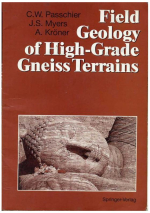Добрый день, Коллеги. Важное сообщение, просьба принять участие. Музей Ферсмана ищет помощь для реставрационных работ в помещении. Подробности по ссылке
Field geology of high-grade gneiss terrains / Полевая геология сильнометаморфизованных гнейсовых ландшафтов
High-gradel gneisses make up a significant part of the continental crust exposed in orogenic belts and in Precambrian cratons. A lot of research has been focussed on high-grade gneiss terrains because they contain a large proportion of the Earth's mineral wealth. Some of these terrains are considered to represent exhumed segments of the lower continental crust and, as such, give valuable insight into processes of crustal genesis.
If we examine any high-grade gneiss terrain in detail, we will usually see a great variety of rock types in layers and lenses with complex geometry and interrelationships. Gneisses with various compositions and internal structures usually occur together. They are generally quartzo-feldspathic rocks with various amounts of biotite, hornblende, diopside, hypersthene, garnet, Al-silicates, cordierite, zircon and opaque minerals. Minor components of gneiss terrains include quartzites, pelites, calc-silicate rocks or marbles, metabasic and ultramafic rocks. The internal structure and interrelationship of rock types in highgrade gneiss terrains are usually complex, because of a long and eventful history. Some of these terrains may have originated as sedimentary rocks that spent a considerable time at deep crustal levels before being uplifted and eroded. Intrusive rocks may have been repeatedly emplaced during several episodes, and the original metasedimentary rocks may consequently form only a minor fraction of the total rock volume (Fig. 1.1). In addition, several phases of ductile and brittle deformation may have complicated the structure of the rocks <...>




